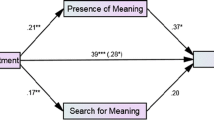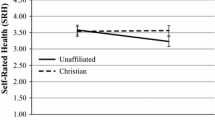Abstract
Religious service attendance predicts increased well-being across a number of studies. It is not clear, however, whether this relationship is due to religious factors such as intrinsic religiosity or due to nonreligious factors such as social support or socially desirable responding. The purpose of the present study was to examine the relationship between religious service attendance and well-being while simultaneously examining intrinsic religiosity, social support, and socially desirable responding as potential mediators of the relationship. A sample of 855 participants (71 % female, average age 19.5) completed questionnaires assessing religiosity, social support, socially desirable responding, and well-being. Path models were estimated using maximum likelihood estimation to analyze the data. Intrinsic religiosity was the strongest mediator of the relationship between religious service attendance and depressive and anxiety symptoms. This suggests that the mental health benefits of religious service attendance are not simply the result of increased social support or a certain response style on questionnaires; rather, it appears that the relationship is at least partly the result of people trying to live their religion in their daily lives.

Similar content being viewed by others
References
Allport, G. W., & Ross, J. M. (1967). Personal religious orientation and prejudice. Journal of Personality and Social Psychology, 5, 432–443.
Batson, C. D., Naifeh, S. J., & Pate, S. (1978). Social desirability, religious orientation, and racial prejudice. Journal for the Scientific Study of Religion, 17, 31–41.
Bollen, K. A. (1989). Structural equations with latent variables. New York: Wiley.
Bradley, D. E. (1995). Religious involvement and social resources: Evidence from the data set “American’s Changing Lives”. Journal for the Scientific Study of Religion, 34, 259–267.
Chida, Y., Steptoe, A., & Powell, L. H. (2009). Religiosity/spirituality and mortality. A systemic quantitative review. Psychotherapy and Psychosomatics, 78, 81–90.
Cohen, S., Mermelstein, R., Kamarck, T., & Hoberman, H. (1985). Measuring the functional components of social support. In I. G. Sarason & B. Sarason (Eds.), Social support: Theory, research and application (pp. 73–94). The Hague: Martinus Nijhoff.
Donahue, M. J. (1985). Intrinsic and extrinsic religiousness: Review and meta-analysis. Journal of Personality and Social Psychology, 48, 400–419.
Ellison, C. G., & George, L. K. (1994). Religious involvement, social ties, and social support in southeastern community. Journal for the Scientific Study of Religion, 33, 46–61.
George, L. K., Ellison, C. W., & Larson, D. B. (2002). Explaining the relationships between religious involvement and health. Psychological Inquiry, 13, 190–200.
Gorsuch, R. L., & McPherson, S. E. (1989). Intrinsic/extrinsic measurement: I/E-Revised and single-item scales. Journal for the Scientific Study of Religion, 28, 348–354.
Hadaway, C. K., & Marler, P. L. (2005). How many Americans attend worship each week? An alternative approach to measurement. Journal for the Scientific Study of Religion, 44, 307–322.
Hadaway, C. K., Marler, P. L., & Chaves, M. (1993). What the polls don’t show: A closer look at U.S. church attendance. American Sociological Review, 58, 741–752.
Hadaway, C. K., Marler, P. L., & Chaves, M. (1998). Overreporting church attendance in America: Evidence that demands the same verdict. American Sociological Review, 63, 122–130.
Hill, P. C., & Hood, R. W., Jr. (Eds.). (1999). Measures of religiosity. Birmingham, AL: Rerligious Education Press.
Jonas, E., & Fischer, P. (2006). Terror management and religion: Evidence that intrinsic religiousness mitigates worldview defense following mortality salience. Journal of Personality and Social Psychology, 91, 553–567. doi:10.1037/0022-3514.91.3.553.
Koenig, L. B., & Vaillant, G. E. (2009). A prospective study of church attendance and health over the lifespan. Health Psychology, 28, 117–124.
Krause, N. (2002). Church-based social support and health in old age: Exploring variations by race. Journal of Gerontology: Social Sciences, 57B, S332–S347.
Krause, N. (2008). The social foundation of religious meaning in life. Research on Aging, 30, 395–427.
Laurencelle, R. M., Abell, S. C., & Schwartz, D. J. (2002). The relation between intrinsic faith and psychological well-being. International Journal for the Psychology of Religion, 5, 177–180.
Leak, G. K., & Fish, S. (1989). Religious orientation, impression management, and self- deception: Toward a clarification of the link between religiosity and social desirability. Journal for the Scientific Study of Religion, 28, 355–359.
MacKinnon, D. P. (2008). Introduction to statistical mediation analysis. New York: Lawrence Erlbaum.
Masters, K. S., & Bergin, A. E. (1992). Religious orientation and mental health. In J. F. Schumaker (Ed.), Religion and mental health (pp. 221–232). New York: Oxford University Press.
Masters, K. S., Hill, R. D., Kircher, J. C., Lensegrav Benson, T. L., & Fallon, J. A. (2004). Religious orientation, aging, and blood pressure reactivity to interpersonal and cognitive stressors. Annals of Behavioral Medicine, 28, 171–178.
Masters, K. S., & Hooker, S. A. (2013). Religiousness/spirituality, cardiovascular disease, and cancer: Cultural integration for health research and intervention. Journal of Consulting and Clinical Psychology, 81, 206–216.
Masters, K. S., & Knestel, A. (2011). Religious orientation among a random sample of community-dwelling adults: Relations with health status and health-relevant behaviors. The International Journal for the Psychology of Religion, 21, 63–76.
McCullough, M. E., Larson, D. B., Hoyt, W. T., Koenig, H. G., & Thoresen, C. (2000). Religious involvement and mortality: A review of the literature. Health Psychology, 19, 211–222.
McCullough, M. E., & Willoughby, B. L. B. (2009). Religion, self-regulation, and self-control: Associations, explanations, and implications. Psychological Bulletin, 135, 69–93.
Morris, R. J., Hood, R. W., & Watson, P. J. (1989). A second look at religious orientation, social desirability, and prejudice. Bulletin of the Psychonomic Society, 27, 81–84.
Muthén, L. K., & Muthén, B. O. (2007). Mplus user’s guide (5th ed.). Los Angeles: Muthén & Muthén.
Nooney, J., & Woodrum, E. (2002). Religious coping and church-based social support as predictors of mental health outcomes: Testing a conceptual model. Journal for the Scientific Study of Religion, 41, 359–368.
Presser, S., & Stinson, L. (1998). Data collection mode and social desirability bias in self-reported religious attendance. American Sociological Review, 63, 137–145.
Saroglou, V. (2002). Religion and the five factors of personality: A meta-analytic review. Personality and Individual Differences, 32, 15–25.
Sloan, R. P., & Bagiella, E. (2002). Claims about religious involvement and health outcomes. Annals of Behavioral Medicine, 24, 14–21.
Smith, T. W. (1998). A review of church attendance measures. American Sociological Review, 63, 131–136.
Smith, T. B., McCullough, M. E., & Poll, J. (2003). Religiousness and depression: Evidence for a main effect and the moderating influence of stressful life events. Psychological Bulletin, 129, 614–636.
Steffen, P. R., & Masters, K. S. (2005). Does compassion mediate the intrinsic religion–health relationship? Annals of Behavioral Medicine, 30, 217–224.
Strawbridge, W. J., Cohen, R. D., Shema, S. J., & Kaplan, G. A. (1997). Frequent attendance at religious services and mortality over 28 years. American Journal of Public Health, 87, 957–961.
Strawbridge, W. J., Shema, S. J., Cohen, R. D., & Kaplan, G. A. (2001). Religious attendance increases survival by improving and maintaining good health behaviors, mental health, and social relationships. Annals of Behavioral Medicine, 23, 68–74.
Trimble, D. E. (1997). The religious orientation scale: Review and meta-analysis of social desirability effects. Educational and Psychological Measurement, 57, 970–986.
Turvey, C., & Salovey, P. (1994). Measures of repression: Converging on the same construct? Imagination, Cognition and Personality, 13, 279–289.
van Olphen, J., Schulz, A., Israel, B., Chatters, L., Klem, L., Parker, E., & Williams, D. (2003). Religious Involvement, social support, and health among African‐American women on the east side of Detroit. Journal of General Internal Medicine, 18, 549–557.
Watson, P. J., Hood, R. W., Jr., Morris, R. J., & Hall, J. R. (1984). Empathy, religious orientation, and social desirability. Journal of Psychology, 117, 211–216.
Weinberger, D. A., & Schwartz, G. E. (1990). Distress and restraint as superordinate dimensions of self-reported adjustment: A typological perspective. Journal of Personality, 58, 381–417.
Author information
Authors and Affiliations
Corresponding author
Ethics declarations
Conflict of interest
The authors report no conflicts of interest.
Informed Consent
IRB approval was obtained prior to beginning the study, and all participants read and signed an informed consent form before participating in the study.
Rights and permissions
About this article
Cite this article
Steffen, P.R., Masters, K.S. & Baldwin, S. What Mediates the Relationship Between Religious Service Attendance and Aspects of Well-Being?. J Relig Health 56, 158–170 (2017). https://doi.org/10.1007/s10943-016-0203-1
Published:
Issue Date:
DOI: https://doi.org/10.1007/s10943-016-0203-1




